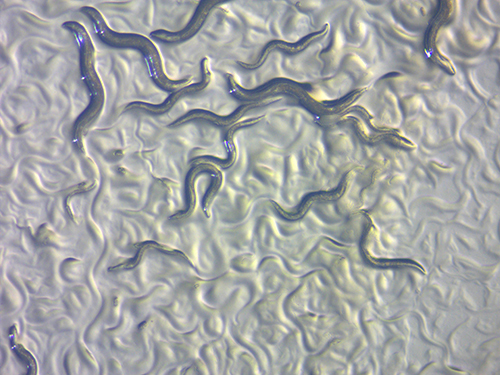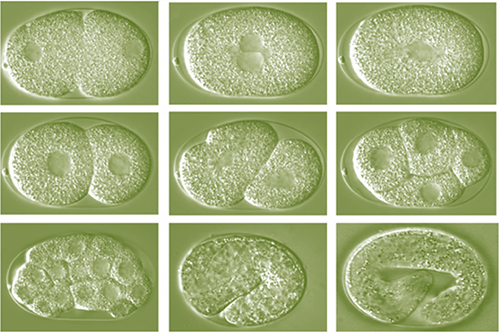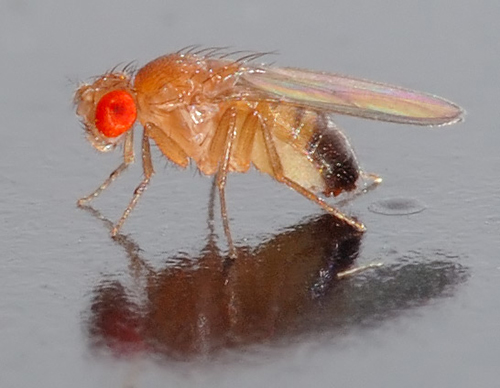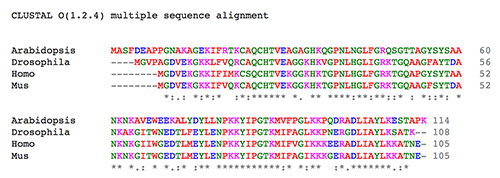Life models Understand article
Model organisms – yeast, worms, flies and mice – help researchers to probe the secrets of life.

survives well in close-packed
conditions.
Image courtesy of ZEISS
Microscopy; image source:
Wikimedia Commons
When we think of a model, we usually think of something smaller and simpler than the original – like a scale-model railway or a pocket-sized version of a classic car. But models are not always toys: maps are models that encode the details of a landscape, and architects and engineers build models to test their ideas before putting them into full-scale practice.
For decades, molecular biologists have used models in a similar way – studying simpler organisms in place of more complex species, including humans. Such ‘model organisms’ often seem to be quite unlike the species they are used to model. For example, Caenorhabditis elegans (usually known as C. elegans) is a worm that is only a millimetre long, and its lifestyle and appearance are of course nothing like those of humans – yet on a molecular scale it shares with us many fundamental processes of life. Studying C. elegans has led to many important findings that apply not only to that species, but to many others. For example, researchers used C. elegans to study the effects of beta-amyloid peptides, the molecules that build up in the brains of Alzheimer’s patients. This has helped to reveal some of the molecular mechanisms that underlie this disease.
Different, but similar
What is the underlying reason for such similarity across species? Comparing the genomes of many different species has revealed that the genes for many key biological functions have been conserved throughout evolution and are now found across species ranging from bacteria to mammals. So, although worms and humans diverged from a common ancestor millions of years ago, some 40%of the coding genes in the C. elegans genome have human counterparts.
The yeast Saccharomyces cerevisiae, a unicellular organism, is perhaps even more remote from humans – yet this model organism has been vitally important for cancer research. This is because the cell cycle – the set of processes through which cells grow and divide – is so fundamental to life that it has been preserved across all eukaryotic species, including yeast. The cell cycle is also crucial to how cancer cells replicate, so studying this cycle in yeast has led not only to increasing our understanding of a basic life process, but also to clinical benefits.

Image courtesy of Fabio Piano / NYU
What makes a good model organism?
Although every model organism has its own advantages, there are some features and advantages that most model organisms share. One of these is small size, as laboratory space is a limited resource. C. elegans scores highly here, as some 10 000 individuals can be kept in a single dish of 10 cm diameter. But perhaps the most important feature shared by all model organisms used in molecular biology, from the bacterium Escherichia coli to the laboratory mouse Mus musculus, is a very short generation time compared to humans. C. elegans, for example, grows from embryo to adult in just three days and has a lifespan of just two to three weeks. This means that experiments involving several generations can be carried out in weeks instead of years.
Using a simpler organism as a model is often an advantage in itself, as it generally makes experiments simpler. For example, the fruit fly Drosophila melanogaster has only four pairs of chromosomes while humans have 23, so Drosophila became a favourite model organism early on for studying how genes are transmitted across generations. It is also a favourite for research linking genetics to behaviour, as it shares with humans and other mammals some important behavioural genes. For example, researchers use Drosophila to investigate the circadian rhythm – the complex biological mechanism that tells us (and flies) when to wake up or sleep. There are fewer factors that influence sleep / wake behaviour in Drosophila than in humans, so it provides a useful simplified model.
Genetic similarity can be another important advantage. The genome of the mouse Mus musculus is similar in size to the human genome, and almost every human gene has a mouse counterpart – which is one reason why this species is so widely used as a model, particularly for human diseases. But sometimes, dissimilarity can also be an advantage: researchers used C. elegans to investigate a human kidney disease with a known genetic cause – even though this species has no kidneys. This meant the organism could stay healthy with the faulty disease-causing gene inserted into its genome, allowing the biochemical pathway that inflicts the damage in humans to be worked out.
Ultimately, the choice of one model organism over another is based on the particular question that researchers wish to investigate. The completely transparent body of C. elegans, for example, is another advantage in developmental biology research: we can observe how every single cell develops in a few days from the fertilised egg, using a simple microscope.

Image courtesy of André Karwath; image source: Wikimedia Commons
Gene technology and the future
Today, continuing improvements in gene editing techniques, combined with information from fully sequenced genomes, are making it increasingly easy to modify the genetic information within living organisms very precisely. Human genes can now be inserted into other organisms that are genetically or anatomically quite different, thus reducing the need to work with species whose genomes are very similar in nature to our own. In addition, bioinformatics – the application of data processing techniques to biology – can now tell us exactly which genes are shared between humans and model organisms.
Together, these technologies provide limitless scope for exploring the causal links between genes and human disease in simple model organisms. Alongside these potential medical benefits, researchers are also exploring new frontiers of knowledge in the science of life, and the common biological systems that connect all living beings.

Image courtesy of EMBL-EBI
Model organisms around us
It’s not necessary to work in a laboratory to encounter model organisms: some of the most important ones are part of our everyday life.
- Escherichia coli (E. coli) is a bacterium found in food and the guts of humans and animals. Most strains are harmless but some can cause food poisoning.
- Saccharomyces cerevisiae is the yeast commonly used for baking bread or for brewing beer.
- Arabidopsis thaliana (thale cress), the main model organism for plant biology, is a small flowering plant that grows by roadsides and in pavement cracks.
- Drosophila melanogaster is the common fruit fly that we sometimes find in our kitchens.
- Danio rerio (zebrafish), a tropical freshwater fish, is a popular and colourful choice for aquariums.
- Mus musculus is the house mouse, which is also sometimes kept as a pet.
Resources
- The website of the international modENCODE project explains how and why model organisms are important in human biology, health and disease.
- To watch the development of C. elegans for yourself, visit the website of the University of North Carolina at Chapel Hill.
- The WormClassroom website offers learning materials about C. elegans for teachers and questions for students.
- The BioInteractive website provides free multimedia science education resources and classroom activities about evolution.
- To learn more about the evolutionary relationships between model organisms, see:
- Hedges SB (2002) The origin and evolution of model organisms. Nature Reviews Genetics 3: 838-849. doi: 10.1038/nrg929
Review
This article is a good starting point for any biology teacher wanting to discuss issues around the use of living organisms in science. It describes a range of species and techniques that help scientists to study biological processes, which can give insights into human diseases such as cancer. The article also highlights the fact that all life on Earth is related, and that the fundamental processes occurring in a simple organism, such as a worm, are similar to those in humans – something which may amaze your students.
In addition to the obvious way of using the article, as a source of information, there is a more subtle approach: an invitation to inquiry. Starting with the information provided, you could guide your students through a process of conjecture and research into the major trends of evolution, particularly the origin of life. For example:
- The trends from simple to complex and small to large
- The need to encode and store information (RNA and DNA)
- The emergence of self-organisation and (short) cycles of replication and reproduction.
Luis M Aires, Antonio Gedeao Secondary School, Portugal





